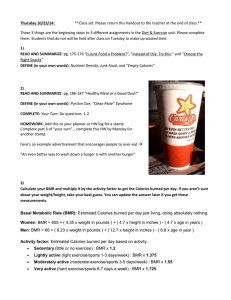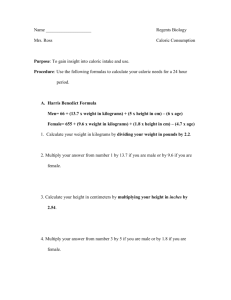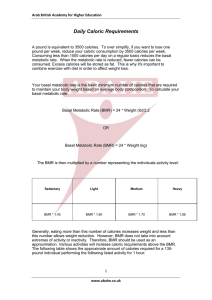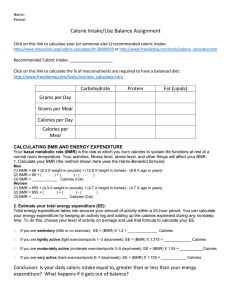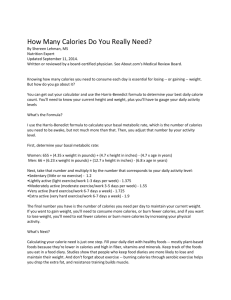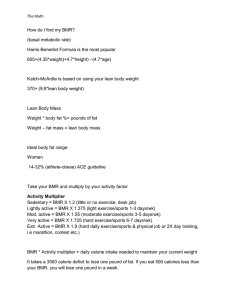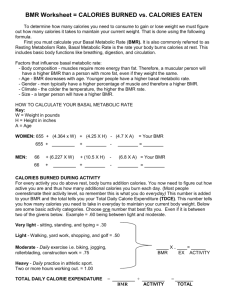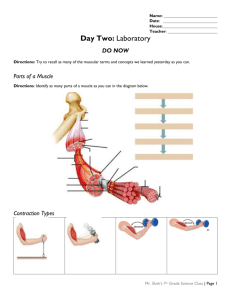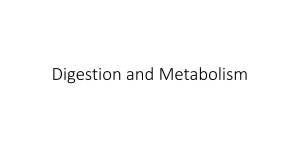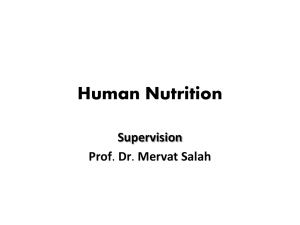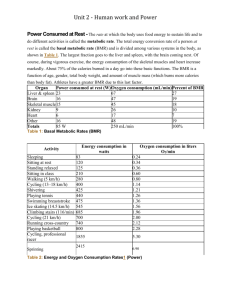Unit 4: Animals My Nutritional Needs Activity Energy: Energy is
advertisement
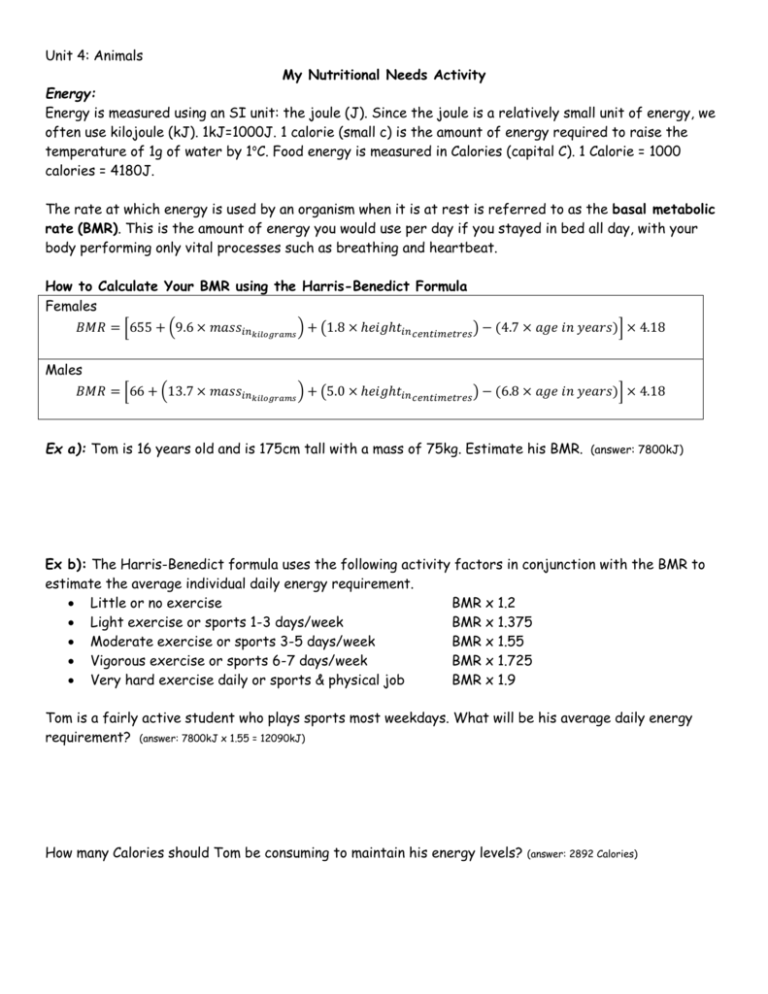
Unit 4: Animals My Nutritional Needs Activity Energy: Energy is measured using an SI unit: the joule (J). Since the joule is a relatively small unit of energy, we often use kilojoule (kJ). 1kJ=1000J. 1 calorie (small c) is the amount of energy required to raise the temperature of 1g of water by 1oC. Food energy is measured in Calories (capital C). 1 Calorie = 1000 calories = 4180J. The rate at which energy is used by an organism when it is at rest is referred to as the basal metabolic rate (BMR). This is the amount of energy you would use per day if you stayed in bed all day, with your body performing only vital processes such as breathing and heartbeat. How to Calculate Your BMR using the Harris-Benedict Formula Females 𝐵𝑀𝑅 = [655 + (9.6 × 𝑚𝑎𝑠𝑠𝑖𝑛𝑘𝑖𝑙𝑜𝑔𝑟𝑎𝑚𝑠 ) + (1.8 × ℎ𝑒𝑖𝑔ℎ𝑡𝑖𝑛 𝑐𝑒𝑛𝑡𝑖𝑚𝑒𝑡𝑟𝑒𝑠 ) − (4.7 × 𝑎𝑔𝑒 𝑖𝑛 𝑦𝑒𝑎𝑟𝑠)] × 4.18 Males 𝐵𝑀𝑅 = [66 + (13.7 × 𝑚𝑎𝑠𝑠𝑖𝑛𝑘𝑖𝑙𝑜𝑔𝑟𝑎𝑚𝑠 ) + (5.0 × ℎ𝑒𝑖𝑔ℎ𝑡𝑖𝑛 𝑐𝑒𝑛𝑡𝑖𝑚𝑒𝑡𝑟𝑒𝑠 ) − (6.8 × 𝑎𝑔𝑒 𝑖𝑛 𝑦𝑒𝑎𝑟𝑠)] × 4.18 Ex a): Tom is 16 years old and is 175cm tall with a mass of 75kg. Estimate his BMR. (answer: 7800kJ) Ex b): The Harris-Benedict formula uses the following activity factors in conjunction with the BMR to estimate the average individual daily energy requirement. Little or no exercise BMR x 1.2 Light exercise or sports 1-3 days/week BMR x 1.375 Moderate exercise or sports 3-5 days/week BMR x 1.55 Vigorous exercise or sports 6-7 days/week BMR x 1.725 Very hard exercise daily or sports & physical job BMR x 1.9 Tom is a fairly active student who plays sports most weekdays. What will be his average daily energy requirement? (answer: 7800kJ x 1.55 = 12090kJ) How many Calories should Tom be consuming to maintain his energy levels? (answer: 2892 Calories) Your Nutrition & Energy Levels: 1. Calculate your own BMR. (Remember that 1kg = 2.2 lbs and that 1inch = 2.54cm) 2. Calculate your own energy requirements based on your activity level. 3. What would be your caloric requirements to meet your energy level requirements? 4. Chose one of the following options to analyze: Option 1: Create a meal plan that would meet your energy level requirements (daily caloric needs) and also fulfill the percentage requirements of carbs, lipids and proteins. Take into consideration all the meals you would require for the day including snacks when preparing your meal plans. Option 2: Write down all of the food you consume in one day and analyze the amount of calories, carbs, proteins and lipids you consume. For either option, you must obtain the information for each type of food and scale it based on the serving size. Use websites like www.caloriecount.com to get the food information. Organize your meals in a table that includes the following columns. You may wish to create a Excel file to help present it. Food Serving Size Calories Carbs (g) Sugar (g) Fibre (g) Protein (g) Fats (g) Food Serving Size Calories Carbs (g) Sugar (g) Fibre (g) Protein (g) Fats (g) Big Mac Chicken breast 1 1 breast 550 282 46 0 9 0 3 0 25 55.2 29 6.2 Example: 5. Complete your totals for each category (calories, carbs, sugars, fibre, fat, protein). Determine if you are meeting the necessary percentages for food requirements. Carbs 45-65% Protein 10-35% Fats 25-35% 6. Determine how much fibre and sugar you are consuming as a percentage of your diet. Do you think this is an appropriate amount? 7. Pretend you are a dietician analyzing your meal plan. Write up an analysis to yourself about the positive aspects of your diet and list some areas for improvement. What changes could you make to your diet to meet your requirements.
